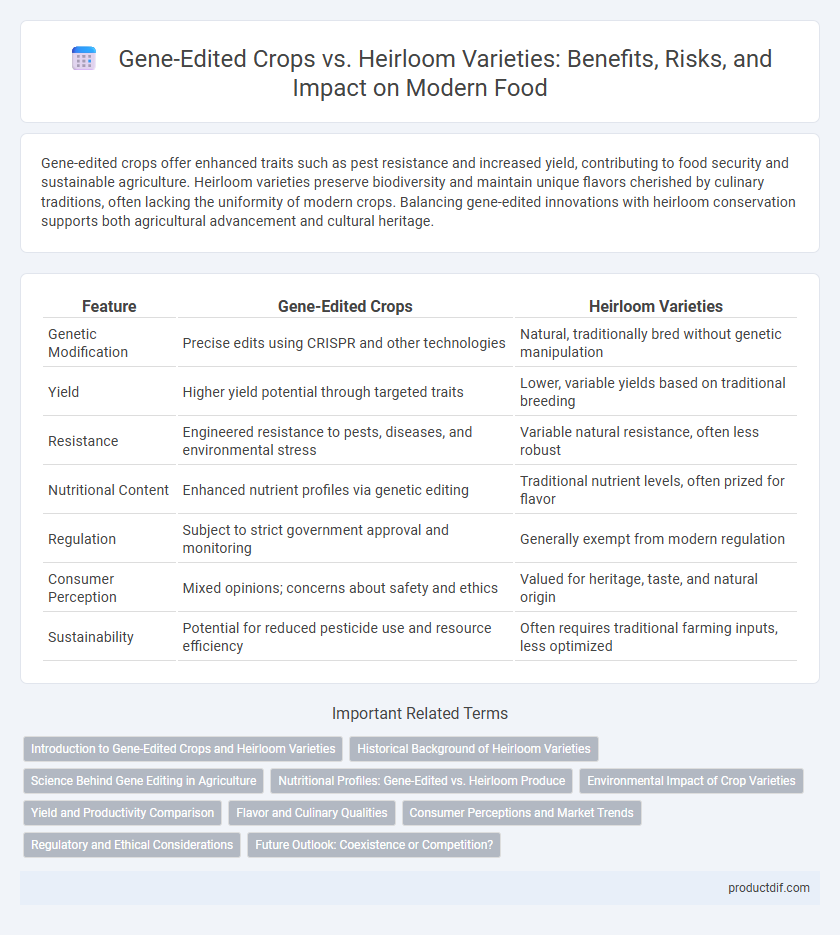Gene-edited crops offer enhanced traits such as pest resistance and increased yield, contributing to food security and sustainable agriculture. Heirloom varieties preserve biodiversity and maintain unique flavors cherished by culinary traditions, often lacking the uniformity of modern crops. Balancing gene-edited innovations with heirloom conservation supports both agricultural advancement and cultural heritage.
Table of Comparison
| Feature | Gene-Edited Crops | Heirloom Varieties |
|---|---|---|
| Genetic Modification | Precise edits using CRISPR and other technologies | Natural, traditionally bred without genetic manipulation |
| Yield | Higher yield potential through targeted traits | Lower, variable yields based on traditional breeding |
| Resistance | Engineered resistance to pests, diseases, and environmental stress | Variable natural resistance, often less robust |
| Nutritional Content | Enhanced nutrient profiles via genetic editing | Traditional nutrient levels, often prized for flavor |
| Regulation | Subject to strict government approval and monitoring | Generally exempt from modern regulation |
| Consumer Perception | Mixed opinions; concerns about safety and ethics | Valued for heritage, taste, and natural origin |
| Sustainability | Potential for reduced pesticide use and resource efficiency | Often requires traditional farming inputs, less optimized |
Introduction to Gene-Edited Crops and Heirloom Varieties
Gene-edited crops utilize precise CRISPR technology to enhance traits such as pest resistance, drought tolerance, and nutritional content, offering faster improvements compared to traditional breeding. Heirloom varieties are traditional plant cultivars preserved for their genetic diversity, unique flavors, and historical significance, often favored for organic and local food systems. While gene-edited crops aim to address food security and sustainability challenges, heirloom varieties contribute to biodiversity and cultural heritage in agriculture.
Historical Background of Heirloom Varieties
Heirloom varieties of crops trace their origins to seeds passed down through generations for over 50 years, often cultivated before the rise of industrial agriculture in the early 20th century. These varieties retain genetic diversity due to selective saving, reflecting regional adaptation and traditional farming practices. Contrasting with gene-edited crops developed through modern biotechnology, heirloom varieties emphasize heritage preservation and natural selection processes.
Science Behind Gene Editing in Agriculture
Gene editing in agriculture utilizes precise tools like CRISPR-Cas9 to modify specific DNA sequences in crops, enhancing traits such as drought tolerance, pest resistance, and nutritional value. Unlike traditional breeding of heirloom varieties, which relies on selecting and crossbreeding existing traits over multiple generations, gene editing enables targeted changes at the molecular level, speeding up crop improvement. Advances in genomics and molecular biology underpin these innovations, allowing scientists to develop crops with improved yield and environmental resilience while maintaining genetic diversity.
Nutritional Profiles: Gene-Edited vs. Heirloom Produce
Gene-edited crops offer tailored enhancements in nutritional profiles, boosting vitamins, minerals, and antioxidants beyond traditional levels found in heirloom varieties. Heirloom produce retains genetic diversity and often presents natural flavor complexity but may lack the targeted nutrient optimizations achieved through gene editing technology. Comparing nutrient density, gene-edited varieties frequently deliver higher concentrations of specific nutrients designed to address dietary deficiencies, while heirlooms provide a broader spectrum of phytochemicals and heritage traits favored by certain consumers.
Environmental Impact of Crop Varieties
Gene-edited crops offer enhanced environmental benefits by reducing the need for chemical pesticides and herbicides, thereby lowering soil and water contamination compared to conventional practices. Heirloom varieties, while promoting biodiversity and preserving genetic heritage, often require more intensive resource inputs and are less resistant to pests and diseases. Balancing the adoption of gene-edited crops with the conservation of heirloom varieties can optimize sustainable agriculture and minimize the ecological footprint of food production.
Yield and Productivity Comparison
Gene-edited crops demonstrate significantly higher yield and enhanced productivity compared to heirloom varieties due to precise genetic modifications that improve resistance to pests, diseases, and environmental stresses. Heirloom varieties, while valued for unique flavors and genetic diversity, generally produce lower yields and exhibit greater susceptibility to adverse conditions. Advances in gene-editing technologies like CRISPR allow for accelerated development of high-yield, resilient crops crucial for global food security.
Flavor and Culinary Qualities
Gene-edited crops are engineered for enhanced flavor profiles and consistent culinary qualities, often targeting increased sugar content, aroma compounds, and texture improvements. Heirloom varieties are prized for their diverse and complex flavors, reflecting traditional traits honed through natural selection and cultural heritage. While gene editing offers precision and uniformity in taste enhancement, heirloom crops provide unique, robust flavors that appeal to artisanal and gourmet cooking.
Consumer Perceptions and Market Trends
Gene-edited crops offer enhanced traits like pest resistance and higher yields, attracting consumers interested in sustainable and innovative food sources, while heirloom varieties appeal to those valuing traditional flavors and genetic diversity. Market trends reveal growing acceptance of gene-edited foods due to regulatory approvals and improved crop performance, yet demand for heirloom varieties remains strong in niche, organic, and farmers market segments. Consumer perceptions are influenced by factors such as labeling transparency, environmental impact concerns, and cultural preferences, shaping purchasing decisions across both categories.
Regulatory and Ethical Considerations
Gene-edited crops face stringent regulatory scrutiny worldwide, with agencies like the USDA and EFSA assessing their safety, environmental impact, and potential allergenicity. Heirloom varieties, often exempt from such regulations due to traditional breeding, raise fewer immediate legal concerns but encounter ethical debates surrounding biodiversity preservation and cultural heritage. Ethical considerations for gene-edited crops emphasize transparency, equitable access, and long-term ecological effects, contrasting with heirlooms' focus on sustaining agro-biodiversity and supporting small-scale farmers.
Future Outlook: Coexistence or Competition?
Gene-edited crops offer precise trait improvements such as pest resistance and drought tolerance, accelerating agricultural innovation, while heirloom varieties preserve genetic diversity and cultural heritage. The future outlook suggests potential coexistence, where gene-edited crops enhance food security and yield, and heirloom varieties support biodiversity and niche markets. Balancing technological advancement with conservation efforts will shape sustainable food systems and agricultural resilience.
Gene-edited crops vs Heirloom varieties Infographic

 productdif.com
productdif.com